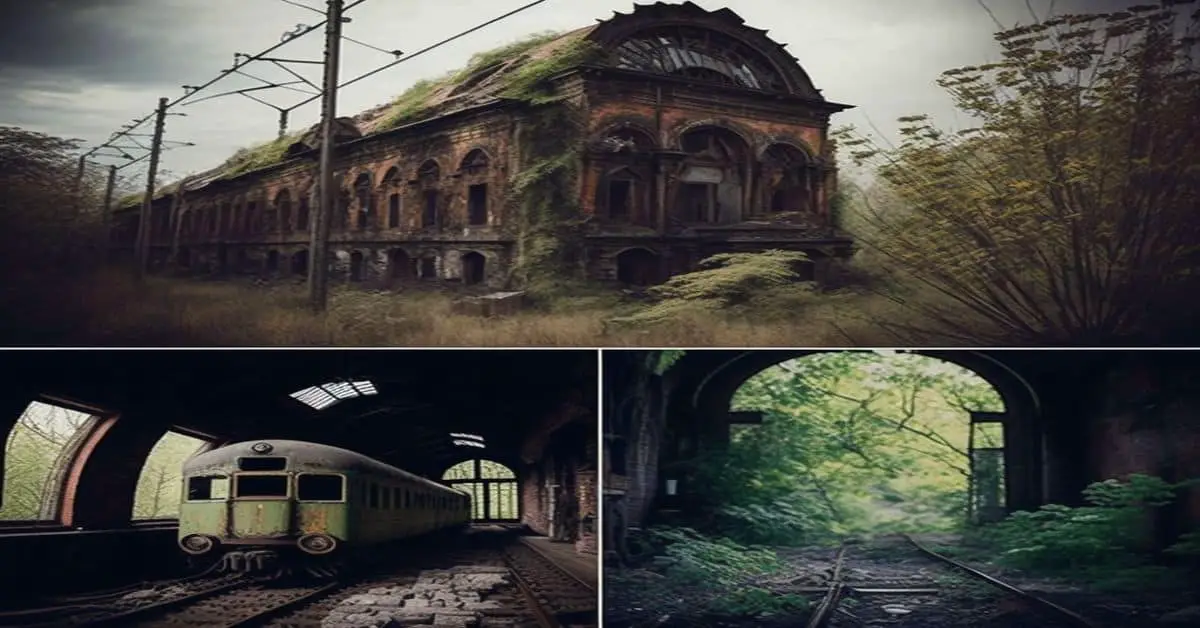Nestled in the northern region of Wadena County, Minnesota, lies the historic site of Shell City, a haunting ghost town that once thrived in the late 1800s.
Like a forgotten memory, the remains of Shell City are a testament to a time long gone, where a bustling town once stood.
Today, visitors can explore the remains of this once-prosperous town, including building foundation depressions, a cemetery, and wagon tracks, all of which offer a glimpse into the town’s past.
The eerie beauty of Shell City lies in its desolate remains. Visitors can wander through the abandoned streets and imagine the lives of those who once lived there.
With signs throughout the site, visitors can learn about the town’s history and the events that led to its ultimate decline.
For history lovers, Shell City is a must-see destination, offering a unique opportunity to experience the haunting beauty of a ghost town and gain insight into a bygone era.
Key Takeaways
- Shell City was once a transportation hub, with a diversified economy that included a button factory, hotel, post office, school, and stagecoach barn.
- The decline of Shell City began after the Great Northern Railroad took a different route, leaving the town disconnected from the main transportation network and resulting in significant economic impact.
- The remains of Shell City can still be seen on its 60-acre historic site, including building foundation depressions, a cemetery, and wagon tracks, providing a unique opportunity to experience the history of the American frontier.
- The cultural preservation of this ghost town highlights the impact of transportation on the growth and decline of small communities, and offers a glimpse into the lives of early settlers in the area.
Location and History
Shell City was a bustling community in the late 19th century in northern Wadena County, Minnesota. Its significance lay in its role as a transportation hub, with wagon trains carrying wheat to the Northern Pacific railhead at Verndale, and a stagecoach line connecting the town to Verndale.
The town’s economy was diversified, with a button factory, hotel, post office, school, and stagecoach barn catering to the needs of the residents and visitors. Despite its importance, Shell City’s decline began after the Great Northern Railroad took a different route, leaving the town disconnected from the main transportation network.
Today, the remains of the town can still be seen on its 60-acre historic site, including building foundation depressions, a cemetery, and wagon tracks. The cultural preservation of this ghost town is significant as it provides a glimpse into the lives of early settlers in the area and highlights the impact of transportation on the growth and decline of small communities.
Remains and Buildings
The 60-acre historic site of Shell City in northern Wadena County, Minnesota, still holds remnants of the past. Visitors can find building foundation depressions, a cemetery, and wagon tracks scattered throughout the area. These remains evoke a sense of nostalgia and curiosity as to what life was like in this small town over a century ago.
A button factory was one of the most intriguing buildings that once stood in Shell City. Although no longer present, the factory serves as a reminder of the town’s industry and its ability to thrive despite its small size.
Additionally, the cemetery holds stories of those who once called Shell City home, providing insight into the lives of the pioneers who settled in this area.
Overall, the remains and buildings at Shell City offer a glimpse into a bygone era and a unique opportunity to experience the history of the American frontier.
Transportation and Decline
With the advent of the Great Northern Railroad, Shell City’s transportation industry suffered a significant decline. Before the arrival of the railroad, wagon trains carried wheat to the Northern Pacific railhead at Verndale, MN, and a stagecoach line was in operation to connect the town to Verndale.
However, the railroad took a seven-mile route to the west, rendering the old stagecoach line obsolete and forcing Shell City’s residents to adapt to the new transportation industry.
The economic impact of the decline in transportation was significant. The town’s wheat trade suffered, and Shell City’s economy took a hit without a reliable means of transportation. The once-thriving town began to lose its population, and the shift in its economic landscape left many residents with a sense of loss.
Despite the presence of the original buildings and signs, the decline of transportation remains a haunting reminder of Shell City’s past.
Frequently Asked Questions
What is the history behind the name “Shell City”?
The Shell City Story delves into the origins and significance of the name, exploring the myths and legends surrounding the ghost town. The history behind the name remains unclear, but it likely references the abundance of shells found in nearby lakes.
Are there any stories or legends associated with the ghost town of Shell City?
There are no stories or legends associated with Shell City. However, some visitors have reported ghostly sightings or supernatural occurrences at the 60-acre historic site, which includes building foundation depressions, a cemetery, and wagon tracks.
What was the local economy based on during Shell City’s heyday?
During the heyday of Shell City, the local industry was primarily based on agriculture, with wheat being the most important resource. The transportation of wheat was facilitated by wagon trains and a stagecoach line to Verndale.
Are there any notable residents or figures associated with Shell City’s history?
No notable residents or figures are associated with Shell City’s history. However, the town’s cultural significance is preserved through the remaining building foundation depressions, cemetery, wagon tracks, and the historic site’s signs.
Has any archaeological research been conducted on the site of Shell City?
There has been limited archaeological research on Shell City, with no known systematic excavations. Exploring ruins may reveal possible hidden artifacts, providing insights into the town’s history and economy.
